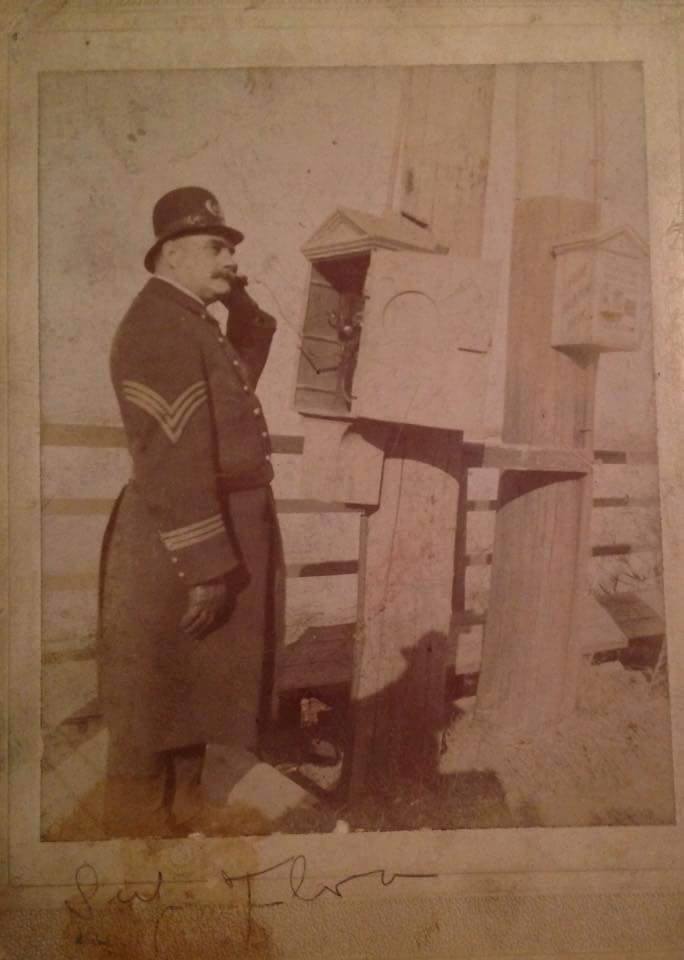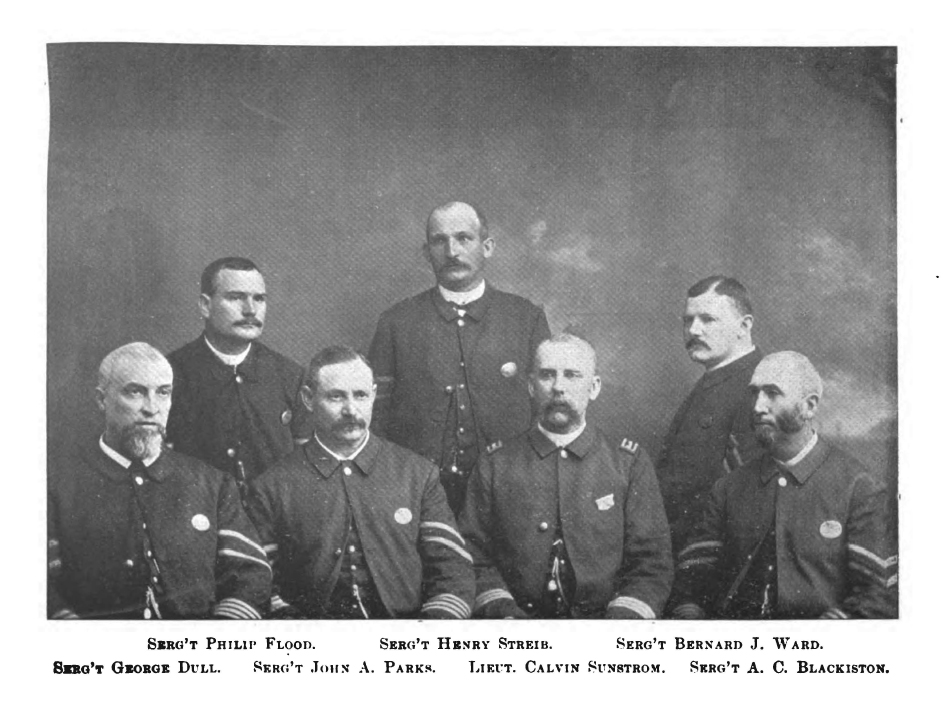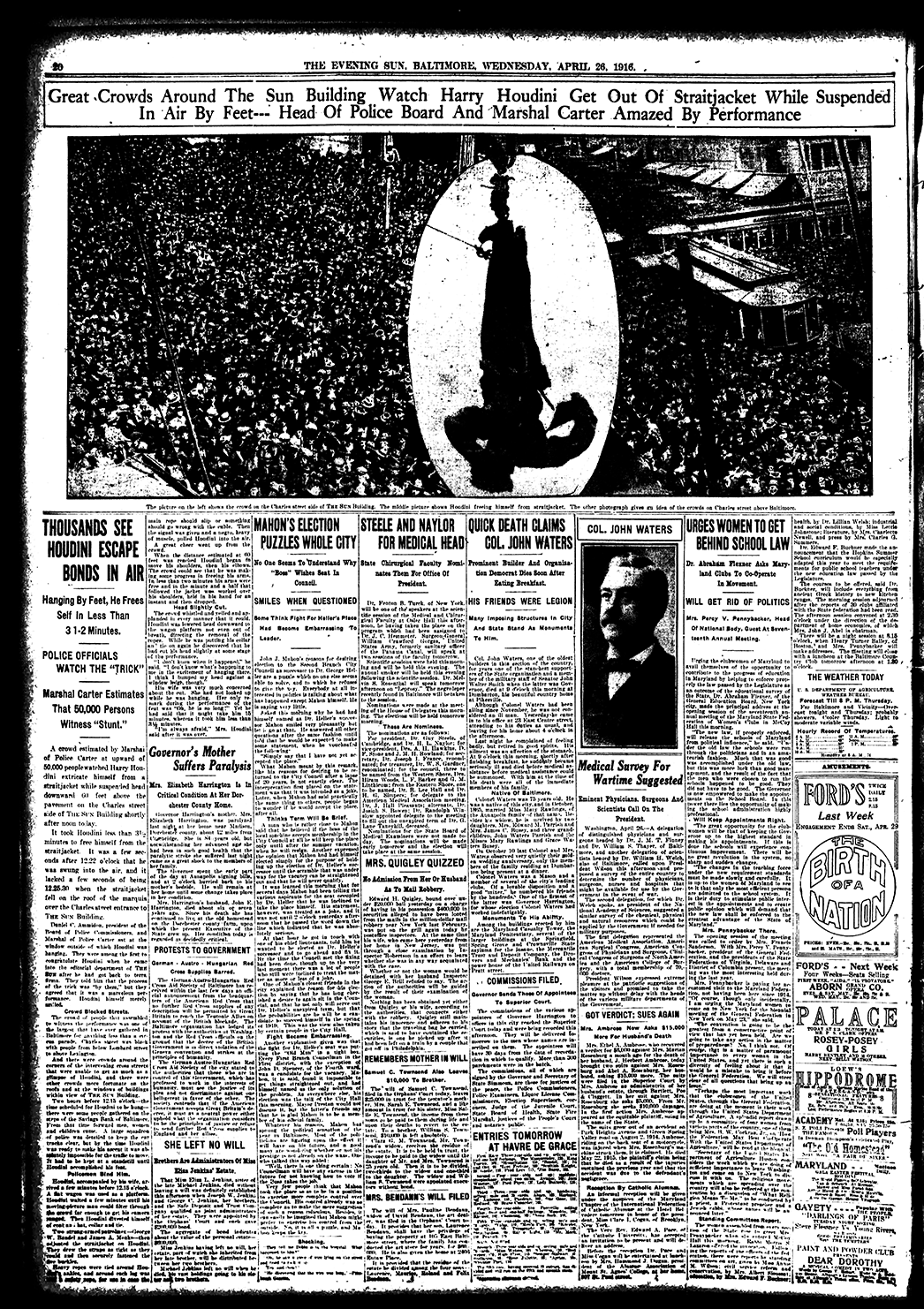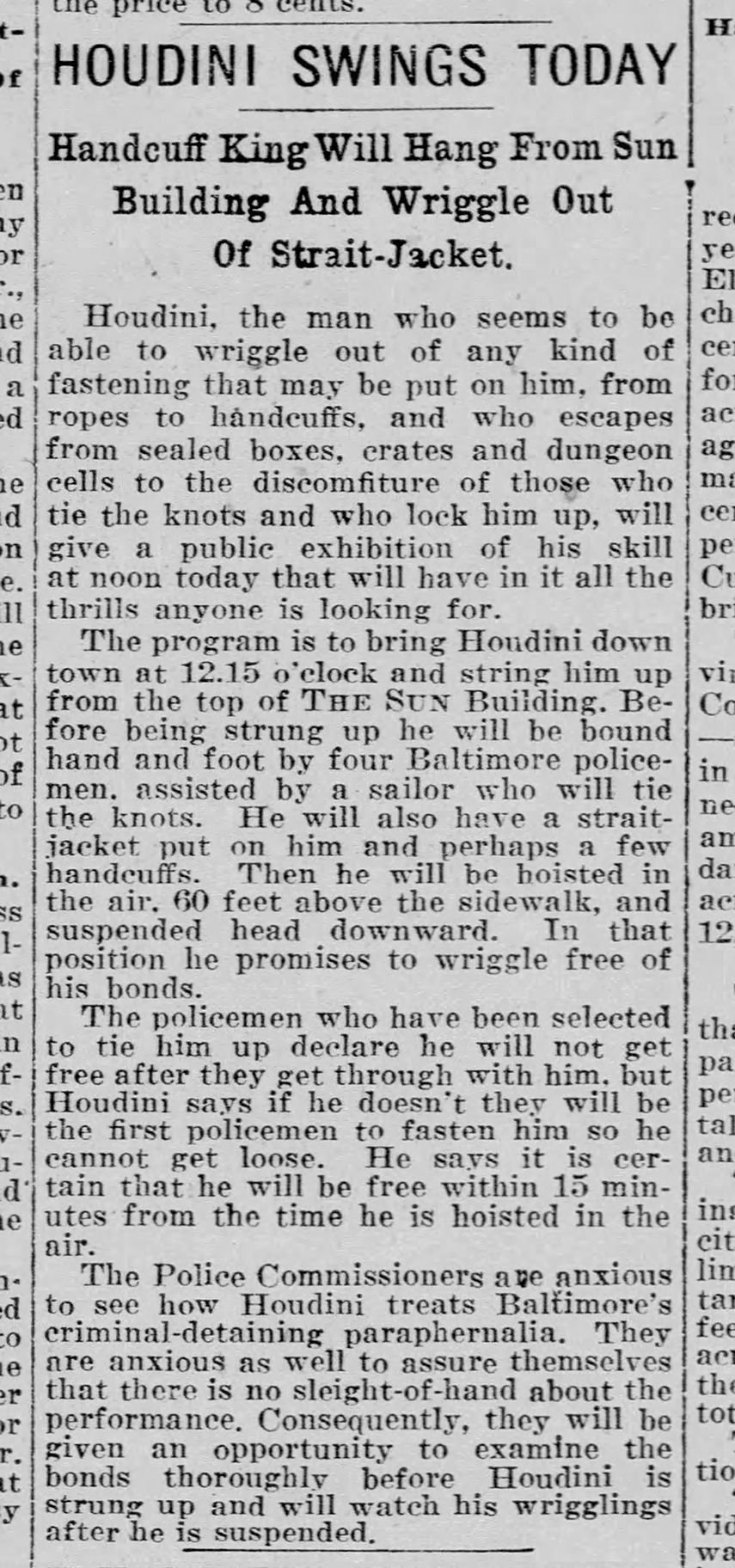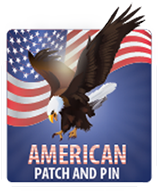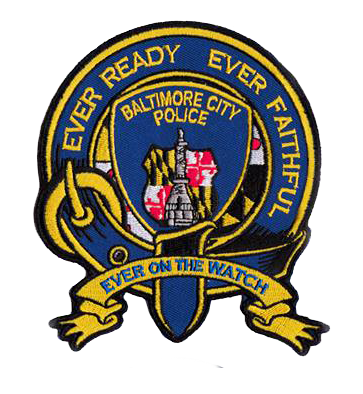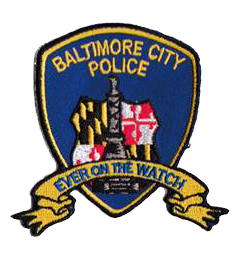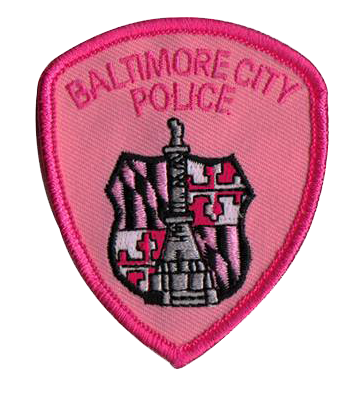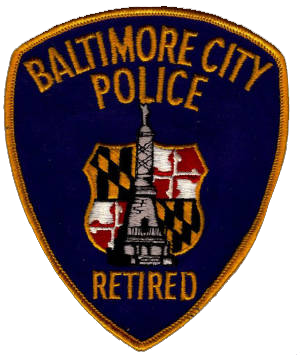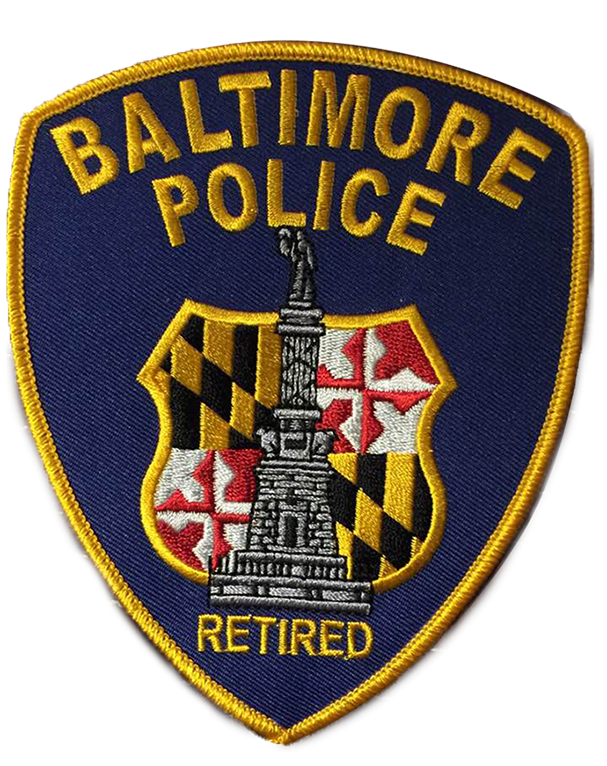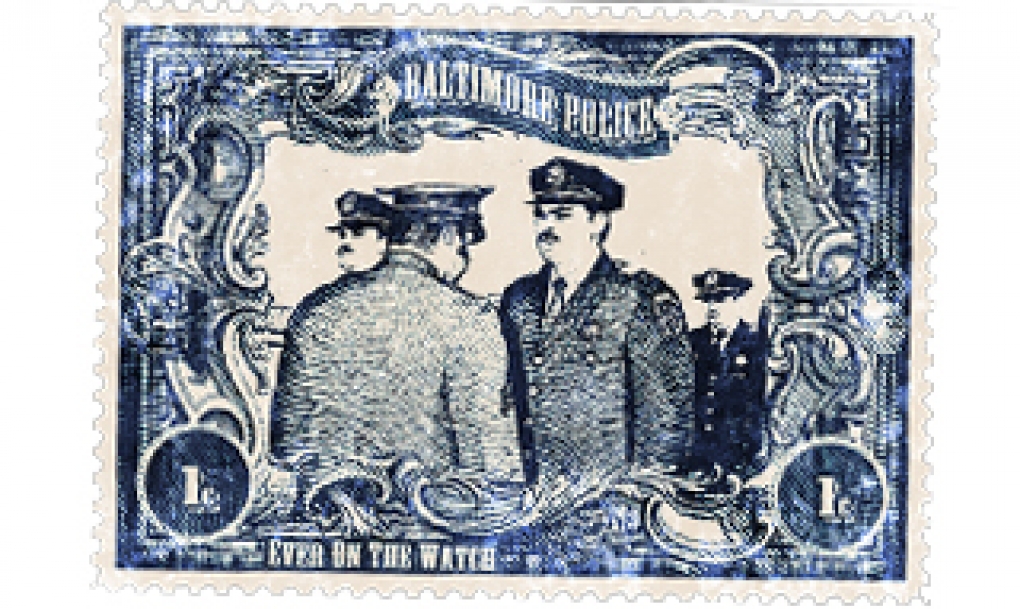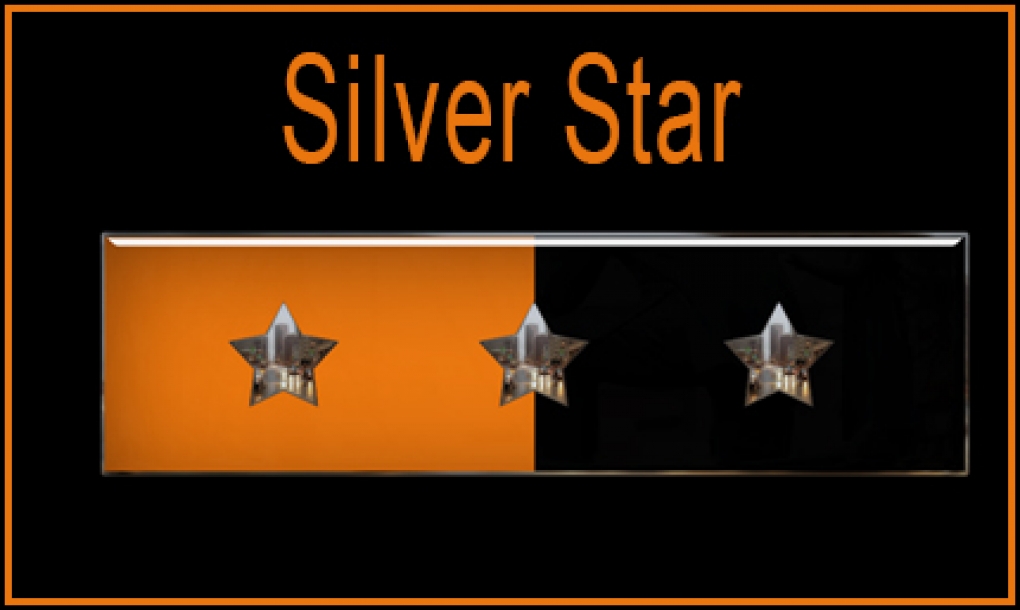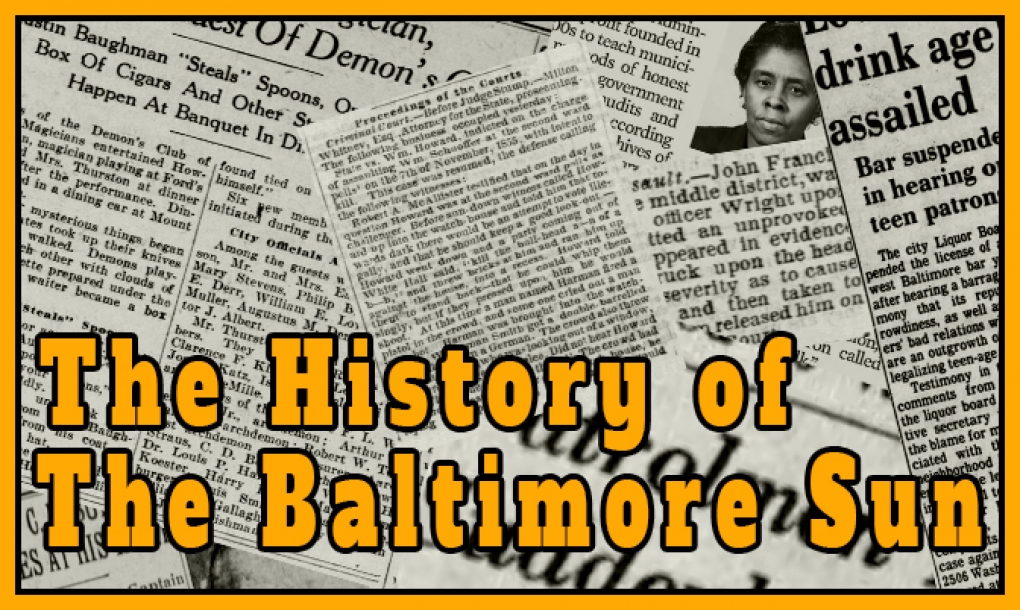The History of The Sun
HAROLD E WEST
May 14, 1922
The Sun (1837-1989);; pg. 117
The History of The Sun
Next Wednesday is the 85th anniversary of the day on which the Baltimore Sun made its bow to the world. Achievements since that they are probably without parallel in the newspaper world. Some of them are hereinafter chronicled by Harold E. West, a veteran of The Sun staff, whose long service is exceeded by that of only gray-haired rival of the reportorial staff and whose devotion to the fine tradition of the flock sun is exceeded by that of none.
The little four-page sheet which appeared 85 years ago is reproduced in its entirety on page 5 – 8 of this section.
Judged by present-day standards, The Sun was an odd little seat when it first made its appearance in Baltimore, 17 may 1837, with its appeal for public approval and support. That was just 85 years ago. It had only four pages, each about half the size of the page of the son of today, and there were four columns on each page.
But for all that The Sun of 1837 was a real newspaper, the first the town had. Not that there were no other papers: there were, several of them, but they were largely journals of opinion, fill with essays, with long communications and with weighty editorials on abstruse subjects. They were all “six pennies,” expensive to buy and hard for average man to read. News had little place in their columns. With his one cent paper, whose mission was the printing of news, Arunah Shepherdson Abell blazed a new trail in Baltimore. With The Sun the news was the thing. Everything else was incidental or of secondary importance. And from this article of his journalistic creed The Sun has never departed.
Odd as the day would seem, its typographical appearance. It’s “makeup,” the arrangement of its news, as advertisements and the news it printed, the son of May 17, 1837, was the son of May 17, 1922 as the Baltimore of 1837 was the Baltimore of today. For the Baltimore of 1837 was an odd little place, a sprawling, overgrown village of about 85,000 inhabitants. Many of its streets were unpaved, and such as were paved were paved with loose stones spread in the roadway or with cobblestones.
And “Campaigner” Even Then
There was no regular police force. The old “Night Watch”, first established in 1775, was still on the job. The watchmen patrolled the streets with lanterns, calling out the time of the night each quarter hour from 10 PM until daybreak. The familiar cry of “12:30 and all was well” was regarded as a necessity, and it was continued until The Sun, in 1843, pointed out that the practice of calling out the time notified thieves and “other evil disposed persons” of the locality of the Night Watch and gave them the opportunity of fixing the time and locality of their operations. Upon The Sun’s recommendation, the practice was abandoned.
Not until the year after The Sun was established in Baltimore have a “day watch,” which consisted of a “high Constable,” one regular policeman for each of the 12 wards, and in each Ward 2 extra men, who could be called upon in emergencies. This, by the way, was a separate organization from the Night Watch, and it was not until 20 years after The Sun was established that the two were combined into one force. In those days would was commonly used as the principal household fuel – coal was freighted down the Susquehanna from the coal regions in “arcs”; the soft coal mines of Maryland and West Virginia had not been opened up; chimney sweeping was a recognized and essential calling, and the grimy slaves made their regular rounds to clean the city’s chimneys of suet as a means of preventing fires.
The Town of Those Days.
The “Meadows,” or “Steiger’s Meadows,” as it was generally known – that stretch of low land line between Calvert Street and Jones falls and what are now Baltimore and Eager Street – was still, to a large extent, unfilled. The city had not been separated from Baltimore County, but was still the county seat.
Roger Brooke Taney had just taken his seat on the Supreme Court of the United States under appointment by Pres. Jackson as Chief Justice to succeed John Marshall; Reverdy Johnson was one of the leaders of the Baltimore bar, and did not yet been elected to the United States Senate, nor become attorney – general; John Pendleton Kennedy was the city’s most promising writer; Johns Hopkins was a leading merchant: the city was even then demanding increased representation in the legislature – it wanted for instead of two members: there was no such thing as a registration of voters, and the city had just acquired peals of museum, on Holliday Street, near Lexington, for a City Hall.
While there was a water company which piped water to more pretentious homes and buildings of the city, a large proportion of the inhabitants secured their water from town pumps, which were on nearly every corner, these pumps going down into Doug Wells. Several large springs also help supply the city with water.
The Society Center
One of these, the city spring on Calvert Street, where mercy hospital now stands, was one of the beauty spots of town. A temple saved dome covered the spring where bubbled up from the ground, and the place was a favorite resort for the gallant and damsels of that day. Calvert, St. Paul, Charles, Lexington, Pleasant, Saratoga, front and Lombard streets were occupied by the homes of the wealthy and fashionable of the city, but even in these homes that tells were not common. What is called “sanitary plumbing” was as undreamed of as the telephone.
Domestic servants were slaves, for the most part, and “free Negroes, were looked upon with disfavor by the white people and the slaves alike. Hoop skirts were in fashion and that “flapper” of that day would’ve died of mortification had her legs been exposed to the gaze of a strange man. Times have changed.
Washington’s Monument had just been completed “on a hill densely covered with trees.” On the outskirts of the city; the cathedral was an almost new building. And Samuel Eccleston was Archbishop of Baltimore. The public school system was in its infancy, there being but eight teachers and about 700 pupils; women teachers were not permitted to instruct even the small boys. The fire department consisted of a number of volunteer companies, which always fought one another first and then turn their attention to the fire. Lotteries were in fashion and were used for the raising of funds for public purposes.
Druid Hill Park was a way out in the county and was still the estate of David N. Rogers, it’s purchase for the park was not having even been considered; Fort McHenry was still an effective defense against the warships of that day.
Lee Then a Capt.
Fort Carol was not begun until 11 years after The Sun made its appearance. Robert E. Lee, who built it and you afterward became commander – in – chief of the armies of the Confederacy, was then a captain of engineer in the United States Army and was superintending the improvements of the harbor of St. Louis and the improvements of the Missouri and upper Mississippi River’s. The Baltimore clipper ships were just beginning to astonish the Maritime world by their wonderful records.
10 years before Charles Caroll of Carrollton, last of the signers of the Declaration of Independence, had laid the cornerstone of the Baltimore and Ohio Railroad, which, in 1837, had only been completed to Harpers Ferry. The Washington branch of the Baltimore and Ohio had just begun. Ross Wimans, a wonderful mechanical genius, had but recently come to Baltimore from his farm in New Jersey and was experimenting in the building of locomotives for the Baltimore and Ohio; people were still talking about Peter Copper’s first steam locomotive, which have been tried out on the Baltimore and Ohio between Mount Clare in Ellicott city. Merchandise was still brought to Baltimore from the West in big wagons, and people traveled almost all together by stagecoach.
When the Streetcars Came
Of course there was no such thing as streetcars. The first bus line in Baltimore was not established until eight years after The Sun first made its appearance, and The Sun commended this enterprise, declaring that: “in other cities, in addition to the general convenience, these lines of tended to enhance the value of property in the outskirts of the big city, enabling persons to reside at a distance from their place of business in more healthy localities, without loss of time or fatigue from walking, whilst the cost is but a trifle.”
“Incidentally, the cost of a ride was 6 ¼ cents, or a “flip,” was was half of a “bit,” which was 12 ½ cents.
Streetcars did not make their appearance in Baltimore until 21 years after The Sun had been established. There was a big fight over their establishment. The Sun favored the streetcars and an old chronicler states that – “a remonstrance against the granting of authority for the street railway was signed by all the businessmen along Baltimore Street but two, these two being the proprietor of The Sun and Messrs. Howell & Bro.”
Barnum’s hotel, on the present site of the equitable and Calvert buildings, was then new and the leading hotel of the city; the old fountain in, on the site of the present southern hotel, was in the height of his popularity, and that famous old structure, the exchange hotel, which afterward became the Baltimore customhouse and post office building, and which was torn down to make way for the present customhouse, was still a popular hotel, much frequented by Southern plant tears and by ship captains and ship owners. In the basement were cells in which the slaves of travelers were kept overnight. The columns from the rotunda and this old building, regarded as the finest white marble monoliths in the United States, now adorn the court of appeals building at Annapolis.
The war of 1812 was still comparatively a recent event and the war the revolution was fresh in the minds of the older people. Dueling had not gone out of fashion. Mothers called their children, when naughty, “little Hessians,” to indicate that they were behaving like the German mercenaries whom George three had hired from Hesse-Darmstadt and it sent to America to help suppress the desire of America for independence.
The Rising of The Sun
Such was the Baltimore of 1837, a funny little town, judged by present-day standards, when, on 17 may, a copy of The Sun, a funny little paper, judged by the same standards, was laid upon the doorsteps of nearly every dwelling in business house in the city. It took just 15,000 copies to go around. The period was one of great business depression, and when the founder of the paper, Arunah S. Abell, investigated the conditions here in anticipation of establishing his journal, he received very discouraging reports from the proprietors of the other papers to whom he had brought letters of introduction. Those on whom he called were Mr. Poe, of the Chronicle; Messrs. Streeter and Skinner, of the transcript; Messrs. Dobbin, Murphy and Bose, of the American; Mr. Gwynn of the federal Gazette, and Mr. Harkerdi of the Republican. In spite of their gloomy predictions, he felt there was an opening in Baltimore for a penny paper and decided to establish it.
Mr. Abell was a New England printer. He had been born in these Providence, R.., On August 10, 1806. His grandfather, Robert Abell was the grandson of Sir Robert Abell, four of whose sons came to America to avoid religious persecution. When Arunah Abell was 14 he left school and got a job in the store of a dealer in “West India goods,” after two years in the store he determined to become a printer and became an apprentice in the office of the Providence patriot, a Democrat journal of the Jeffersonian school.
Three Musketeers Set Out
With this paper Mr. Abell “served out his time,” and as a journeyman printer started out into the world to make his fortune. There were no railroads and he went from Providence to Boston by stagecoach, and in Boston got himself a job in a print shop. From Boston he later went to New York and promptly secured employment. Here he met his future partners, William M. Swain and Azariah age. Simmons, both practical printers.
The “penny press” had just secured a foothold in New York and the three ambitious young men discussed the advisability of establishing another penny newspaper there. It didn’t take a great deal of money to establish a newspaper in those days. Mr. Abell felt that the New York film was fully occupied, but agreed to go in which Messrs. Swain and Simmons in the establishment of a penny paper in Philadelphia, which at that time had no paper of that sort. The others agreed, and on 29 February 1836, the articles of agreement were drawn up which resulted in the establishment of the public ledger.
Investigates Possibilities Here
In spite of early difficulties, the ledger became firmly established in a year, its future seemed secure, and it occurred to Mr. Abell to come to Baltimore to investigate the possibilities of establishing a similar paper here. He felt the Baltimore field was a fertile one and so reported to his Associates, who agreed to the establishment of another paper, provided Mr. Abell should organize it, assume the immediate responsibility and personal control.
This was satisfactory to Mr. Abell: type of material were ordered and the most modern president day was bought. An office was secure at 21 Light St., the second door from Mercer, and on 17 may, 1837, the son was born. In its salutatory it declared that its object was the furnace a newspaper equal to any, at a price which would bring it within the means of all who could read, and of the large number of persons to whom the more expensive dailies were inaccessible. It also made some distinct pledges as to the rules which should govern the editorial conduct of the paper. It declared:
We shall give no place to religious controversy, nor to political discussions of merely partisan character. On political principles and questions involving the interest or the honor of the whole country it will be free, firm and temperate. Our object will be the common good, without regard to that of sects, factions or parties, and for this object we shall labor without fear or partiality. The publication of this paper will be continued for one year at least, and the publishers hope to receive, as they shall strive to deserve, a liberal support.
The Sun was very much better received in Baltimore than the ledger had been received in Philadelphia. In less than three months it had a larger circulation than the ledger has gained in nine months. Within a year it circulated twice as many copies as the oldest established journal in Baltimore. It has been often said that his success was more immediate and more rapid than has attended any similar enterprise in the country.
Not that it was all easy and plain sailing: not that there were no trying times and dark days for there were, but it was not long before The Sun outgrew its limited quarters on light Street, and on February 16 it was moved to the southeast corner of gay and Baltimore streets. These quarters two, were soon outgrown, for The Sun had secured the confidence of the community and its business was developing by leaps and bounds.
The Sun Iron Building
It was decided that before making another change a site should be purchased and a building erected for The Sun’s own purposes. This building, it was determined, should be an ornament to the city which had so graciously supported this newspaper. Mr. Abell was authorized to select the site, and after looking over a number of lots he settled on one, then in the very heart of the business district, at the southeast corner of South and Baltimore streets, which, incidentally, had been the site of the first newspaper published in Baltimore – the old Maryland Journal and Baltimore advertiser, published by William Goddard. The whole site chosen for The Sun’s new home was occupied by five old brick buildings and cost approximately $50,000.
It had been determined that the building to be erected should equal, if not surpass, any of the business structures then in Baltimore, and a good deal of the time was devoted to the discussion of plans. At about this time James Bogardus, of New York, was in Baltimore looking for an opportunity to test out his invention for the construction of buildings of iron. New York had received his proposition coldly, so he had come to Baltimore hoping to find his chance here. He was almost in despair when he submitted his plans to the owner of The Sun. They gave his plans the most serious consideration and became convinced of their feasibility.
Mr. Abell therefore entered into a contract with Mr. Bogardus for the erection of the building according to the Bogardus plan, specifying, however, that the CASTINGS should all be made in Baltimore, although Mr. Bogardus wanted them to be made New York, where he resided, and where, with more convenience to himself, he could superintend this part of the work.
The CASTINGS were made in the foundry of Benjamin S. Benson and were remarkable specimens of foundry work. The ornamentation on the columns – full-length figures of Washington, Jefferson and Franklin – and the various medallions with which the building was ornament, where is clear and sharp as if cast in bronze.
This building was completed in 1851, and The Sun moved into it one 13 September of that year. It was the first iron building in the world: it was known as The Sun iron building, and architects and builders came from all parts of the country to inspect it. So successful was it that more orders flowed upon Mr. Bogardus than he could fulfill and for a time practically all the new business buildings in Baltimore were built of iron. This building houses The Sun until the great conflagration (Fire) of 1904, when it went down with a large part of the business section of the city. Mr. Simmons, of the firm of Swain – Abell and Simmons, resided for a time in Baltimore soon after The Sun started, and assisted Mr. Abell in the management of the paper. He soon returned to Philadelphia, however, and with Mr. Swain, devoted himself to the management of the ledger. Leaving The Sun and sold charge of Mr. Abell.
New Partnership Formed
This arrangement continued until the death of Mr. Simmons in 1855, which dissolved the original copartnership. The two surviving partners immediately formed a new firm of Swain and Abell, and continued as before the publication of The Sun and the Philadelphia ledger, their interests in the two papers being equal. As Mr. Swain lived in Philadelphia and Mr. Abell in Baltimore, it naturally resulted that the management of the ledger and its affairs fell to Mr. Swain, while The Sun continued under the management of Mr. Abell.
Gradually, however, Mr. Swain’s health began to decline and he was unable to give the ledger his active personal supervision. The Civil War, too, broke out, and Mr. Abell’s duties to the Baltimore paper became difficult and erroneous. He strongly sympathized with the South in his position and that of The Sun were not free from danger. To complicate matters Mr. Swain took the extreme northern view of the conflict between the sections.
Under these circumstances, Mr. Abell notified Mr. Swain that he was willing to dispose of his interest in the ledger, and after lengthy negotiations the ledger was, on three December, 1864, sold to George W. Childs and Drexel & company, bankers, of Philadelphia.
After the sale of the ledger, The Sun was conducted by Mr. Abell alone as agreed upon between his partner and himself until 16 February, 1868, when Mr. Swain died. Mr. Abell then sold his interest in the ledger building and other real estate in Philadelphia, which he had held in common with Mr. Swain, to Mrs. Swain and her two sons, and they in turn sold all their interest in The Sun, The Sun iron building and other real and personal property here to Mr. Abell, thus completely severing the old interest.
News Gathering Unimportant
In the first year the son’s life established its reputation as a news gather which has not been excelled by papers anywhere. When the publication of The Sun was begun it had but one reporter. History Abell himself often set type, wrote editorials and edited and “made up” the paper.
No regular reports of local events were given by any of the city papers until the custom was established by The Sun. Not even the proceedings of the courts or of the legislator were then reported by the Baltimore papers, nor those of Congress, the Baltimore paper depending upon those of Washington to furnish them the following day with whatever of interest that occurred in Congress.
The president’s message of December 1838, offered The Sun its first big opportunity of displaying its newsgathering enterprise. The other Baltimore newspapers were custom to obtaining their supplements with the president’s message from Washington, printed with the headline of the Baltimore paper, transmitted by mail and delivered to Baltimore readers the next day, and possibly later.
Pony Express Developed
The Sun determined upon something more up-to-date. Through posting a “friend, mounted on a Canadian pony, nimble as a goat and fleet as the wind” at the “outer depot,” the printed copy of the message was brought to the office on light Street, and in five minutes after its arrival 49 compositors were at work on it and in two hours the first copy printed in Baltimore was handed to the crowd which filled the office. Thus The Sun anticipated all its contemporaries by two days.
This. Of enterprise had so developed the business of The Sun that on 30 March, 1840, the paper had to be enlarged. This was followed by another display of enterprise when The Sun spread Pres. Harrison’s inaugural address before it’s Baltimore readers on the same day it was delivered, winning from one of its Western contemporaries (the Louisville Gazette) the complementary remarked that –
“in the enterprise of the war the proprietors of The Sun we have an example worthy of all praise; they have on this occasion of their prompt and untiring energy, placed the whole Western and nearly all the southern part of the country in possession of this important document at least 24 hours in advance of all its contemporaries.”
Of the New York and Philadelphia papers, only those in exchange with The Sun receive the early copy
Foreign News Gathered Also
These were not merely spirits of enterprise. The pace was kept up. The death of Gen. Harrison, the address of Pres. Taylor, the message to the extra session of Congress followed in the same prompt and rapid manner. The Sun ran a pony express from Boston to Baltimore, a distance of about 400 miles, and beat all the other Baltimore papers with the foreign news, which in those days arrived by ship to Boston, as well as with the news of the northern part of the country.
This was the beginning of the newspaper pony express, which, until the telegraph was established and reached over the country, and able to sun to be always ahead of its contemporaries. The feet of the fiscal bank bill in 1841 was first made known in Baltimore through The Sun by “horse express,” and the trail of the lead, in the “CAROLINE” affair, which took place in Utica, and. Why., In October 1841, was reported especially for The Sun and transmitted partly by rail and partly by pony express. The trail lasted several days and as it was thought to involve the issue of another war with Great Britain excited the greatest interest throughout the whole country.
New York Learned Something
The New York papers, which have been allowing the Baltimore Sun to “scoop” them right and left on matters of national importance, woke up in 1844 and for the next three years extensive expresses were run with European news from Halifax to Boston. Into these enterprises The Sun entered as a leading spirit.
The relations with the United States and Great Britain growing out of the Oregon matter were of intense interest and every bit of the news relating to them was eagerly sought. Halifax and Boston were the chief points of the reception of this news, and as the time of the steamers from those points to New York were very slow the newspaper had to arrange other means for getting this news promptly. The Sun entered the combinations with New York papers and exclusive extras were issued from its office and sent by express trains to Washington, thus furnishing the president and his cabinet the earliest intelligence.
The news, was brought by the ship liberty and the steamer Cambria, was thus given to the people of Baltimore and Washington, the West and the South at least 24 hours ahead of “blanket sheets.”
The expresses from Halifax were “planned on an extensive scale and were considered to be the most extraordinary evidence of newspaper enterprise ever brought before the American people.” So they were described by the historian of that day. A relay of horses extending from Halifax across Nova Scotia to Annapolis on the Bay of Fundy, a distance of more than 150 miles, connected at Annapolis with a steamer, which carried the news packets to Portland, Maine. They were carried thence to Boston by locomotive, thence via New York and Philadelphia to Baltimore. The whole distance was more than 1000 miles and the time about 50 hours
Even Chartered Ocean Vessel
The Cambria’s news was awaited with more interest than that of almost any steamer that ever arrived in the country. The railroad and Steamboat lines were under contract to run expresses with their advices. The Sun was only Baltimore paper to print the news she brought. The news of the Hibernia was received by The Sun on 20 March 1946, from Halifax, and 62 hours and 45 minutes and was immediately published in an extra. The Sun was the only Baltimore paper that joined in the charter of the pilot boat Romer to run to Liverpool and return with foreign news.
When the war with Mexico turned the news point of the compass to the south The Sun stepped immediately to the front rank of enterprise in procuring early and reliable news from the seat of war. In this respect, it was conceded that it excelled any paper in the country. To meet the demand for news of the Mexican war Mr. A. S. Adele, early in 1846, established exclusively for the Baltimore Sun “without consultation or previous arrangement or agreement with any other paper,” and overland express from New Orleans, comprising about 60 blooded horses.”
First News of Mexican War
Notwithstanding the obstacles thrown in the way of the success of this enterprise by the postal authorities the express almost in variably beat the great Southern mail from New Orleans to Baltimore by more than 30 hours. As the war progressed these expresses became a public necessity, and in view of the great satisfaction with which The Sun’s efforts In this direction was received several northern papers joined with it in the enterprise. The trip was usually made from new Orleans to Baltimore in six days at an expense to the Baltimore Sun of about $1000 a month
117 October, 1846, The Sun laid before traders and engraved representation of Monterey, its vicinity, its fortification and the advance of the American troops, drawn for the war department to Capt. Eaton. This was followed on six November by a “view of Monterey and the American Army prior to the battle.” This enabled the readers of The Sun to locate the principal forts, the main buildings of the city and the position of the American Army, according to division, brigades and regiments. On three April following the sons published a map of the battlefield a Bona Vista, showing the topography of the country, which had been drawn by an engineer on the staff of general Wool.
The News Triumph of 1847
110 April – 1847, The Sun was the first to announce to the president and his cabinet at Washington and to the citizens of Baltimore, “the fall, surrender and unconditional capitulation of the city of Veracruz in the Castle of San Juan d’Ulloa.”
This piece of newspaper enterprise was heralded in all parts of the United States, and upon the reception of the news in Washington, on Saturday morning, 10 April, in the columns of the Baltimore Sun, it caused universal rejoicing. The Washington union of the same afternoon said;
“The whole city was filled with enthusiasm today by the accounts, for which we are in debt to the Baltimore Sun, through the extraordinary express from Pensacola. The Sun must’ve run and express through the city last night. It shows what enterprise can do, and no press has done more experiments of this nature than The Sun.”
Aid to Federal Government
While it’s “punctual and never failing” team of ponies kept The Sun supplied with news far in advance of its contemporaries this news was never used for personal or improper purposes. The practice of the paper on the arrival of European news was to issue a bulletin or “slip synopsis” of the markets at the earliest possible moment, thus placing at the disposal of the whole community valuable information that could be obtained in no other way. The government at Washington was also kept advised of every important event transpiring at the seat of the war.
The Sun was particularly instrumental at this time in serving governmental interests. In referring to this on one occasion The Sun said:
“It was generally admitted that the news of the capture of Veracruz, arriving by our express on the very day appointed for the close of a national loan, was directly favorable to the national interest in the final negotiations.”
Before the publication of this intelligence, even the columns of The Sun, Mr. Adele sent a private telegraph dispatch to the president of the United States announcing the event and received an acknowledgment in which the “zeal and enterprise” of the paper were commended.
Victory at Churubusco
The ponies of the Baltimore Sun on 15 September again made a record and brought the news of the brilliant victories at Contreras and Churubusco, distancing stages, railroads, steamboats and telegraphs and enabling The Sun to publish this news in advance of all its contemporaries. They next brought in the news of the operations in the vicinity of the Halls of Montezuma, which were announced thus on for October:
Our pony team, as if in anticipation of the great excitement prevailing in the city on Saturday evening to October, came flying up to the stopping post with the most thrilling and important intelligence yet received from the seat of war, for 24 hours ahead of steamboats, railroads and even telegraphs. The news brought by them 24 hours in advance of the mail being of such exciting and thrilling interest we put the press at a late hour on Saturday night and extra son with full details, which were sought after by our citizens during yesterday morning.
The addition of the southern daily pony express on 29 November, 1847, completed the arrangements of The Sun for obtaining news from the seat of the war, and thereafter, until the war ended, readers of The Sun received every morning the very latest news of the operations of the Army’s.
Carrier Pigeons Next
About the time the pony expresses were being so successfully used for the transmission of news Mr. Adele conceived the idea of using carrier pigeons for the same purpose, especially for short dispatches. Accordingly, he organized the first carrier pigeon express ever known in this country for the sending of dispatches between New York and Philadelphia Baltimore and Washington DC. About 500 pigeons were trained for this service and were kept in a house on Hampstead Hill, near the old Maryland hospital for the insane.
Foreign steamer news was frequently obtained in this way, and on more than one occasion a synopsis of the presidential message were brought by the pigeons to Baltimore immediately after its delivery to Congress, and published in extras, to the great surprise of the public. This carrier pigeon service was maintained until the telegraph was developed enough to supersede.
While the pony express were the quickest means at the time of securing news from distant points, The Sun was looking for something even quicker. Prof. Samuel F. B. Morse had worked out a magnetic telegraph and had petitioned Congress for assistance to enable him to conduct an experimental line between Baltimore and Washington. Congress was so incredulous that his measure never got out of committee. This was in 1837, the year The Sun was established
five years later, in 1842, Prof. Morris renewed his application, which was strongly endorsed by The Sun. John Pendleton Kennedy, of Baltimore, was then a member of Congress and chairman of the House committee to which the bill had been referred to. Mr. Kennedy worked hard for its passage, and on 3 March, the last day of the session, the bill, appropriation: $30,000 to test out the practicability of the invention, went through. The experimental line was to be run from Baltimore to Washington and the first advertisement for materials for the line was inserted in the Baltimore Sun on 30 March, 1843. The line was completed by 24 March 1844 and The Sun became one of its most constant patrons, using the service whenever it was possible to use it.
The First Great Wire Message
The first presidential message ever transmitted over the wire was sent exclusively to The Sun on 11 May, 1846.
This achievement was the forerunner of the establishment of the telegraph in France. The Sun’s telegraphic copy of the message was reprinted by the Academy of science at Paris, side-by-side with an authenticated transcript of the original. The Paris correspondent of the national intelligence, speaking of this event in the French chamber of deputies, said:
Prof. Morris had the goodness to send me an account of the recent achievements of the electrical telegraph with a copy of the Baltimore Sun containing the president’s message on the Mexican war as it was magically transmitted to that paper. I sent the communications to Pouillet, the deputy author of the report hereto for submitted to you, and he placed them in the hands of Arago, who submitted their very interesting and decisive contents to the Academy of science and the chamber of deputies.
In the chamber on the 18th inst. when the proposal appropriation for electrical telegraph from this capital to the Belgian frontier came under consideration, barrier opposed it on the ground that the experiment of the new system or incomplete: that it would be well to wait for the full trial of what was undertaken between Paris and Rouen. Arago answered:
“The experiment is consummated: in the United States the matter is settled irresistibly. I received three days ago The Sun, of Baltimore, with a letter from Mr. Morris, one of the most honorable men of this country, and there is the president’s message, printed from the telegraph in two or three hours. The message would fill four columns of the Moniteur ; it could not have been copied by the most rapid Penman in a shorter time than it was transmitted. The galvanic fluid travels 70,000 leagues per minute.”
The appropriation of nearly half Fr.1 million passed with only a few dissenting votes.
Their discussions over the practicality of the invention and the backing was the son gave the enterprise resulted in the establishment of a strong friendship between Prof. Morris and A. S. Adele, and when a company was afterward formed for the extension of telegraphic facilities from Washington to New York The Sun firm of swine and Adele and Simmons was associated in the enterprise with Prof. Morris, Richard M. Hoe, of New York, the great printing press manufacturer of that time, also a strong friend of Mr. Adele, and a most candle and beep. Beep. French of Washington.
Telegraph is Organized
A great deal of difficulty was found in raising the money for the enterprise in New York and Philadelphia, so the publishers of The Sun and the Philadelphia ledger, with a few friends in Baltimore and Philadelphia, supplied the money needed for the Baltimore Philadelphia extension. The line being opened on 21 April, 1846. When The Sun iron building was completed the offices of the telegraph company were moved into it and were maintained there during the infancy of the enterprise and for many years thereafter.
The value of the telegraph in securing electric returns from distant points was early recognized by The Sun and it was among the first newspaper in the country to use the telegraph for this purpose. In this work and in receiving the news of Congress by wire control C Fulton, then a reporter on The Sun and later proprietor of the American, was especially expert. He developed it as a specialty and for a considerable period handled most of the telegraphic news received by The Sun.
First Cable News to Baltimore
The short-lived Atlantic cable of 1858 was also made to do service for the Baltimore Sun even in the very few moments of its serviceable existence by sending a special dispatch exclusively to The Sun, which was the first news telegraph from London over the Atlantic cable received and made public in Baltimore.
The Civil War
Was trying period was trying one for The Sun. While it was always moderate and dignified in his utterances and in its comment upon the issues involved in the controversy between the North and South, it’s sympathies were strongly with the South. The military occupation of Baltimore by the federal authorities was very trying hosts of the most prominent citizens of the place were arrested and confined in Fort McHenry or sent to distant prisons and the military authorities work constantly watching for an opportunity to suppress The Sun. For a large part of the time a federal Marshall was posted in the building.
“Getting” The Sun
As there could be no such thing as a free discussion of the issues, The Sun became silent and throughout the war utter not a word editorially, confining itself solely to the printing of the news. Editorially, it maintained a silence more impressive than any word it would have been permitted to utter.
At one time in order for the closing of The Sun and the arrest of Mr. Abell was actually issued by the war department and was about to be transmitted to the commander of the forces of Baltimore when Mr. Adele received information of it. He had an earnest and effective protest entered against such a proceeding and the execution of the order was suspended.
The motive which had instigated it was betrayed a day later 12 noted politicians: Mr. Abell at his office and offer to buy The Sun. They anticipated that the fate of other prints which had been suppressed and their editors imprisoned staring him in the face he would be only too willing, if not thankful, to retire from his dangerous position and be rid of his precarious property at any sacrifice. They intimated as much. They were accordingly surprised and disappointed when they found the design was thoroughly understood and they were told that The Sun was not for sale at any price.
The close of the war found Maryland in a trying position. She had been of the middle ground during the struggle, and her people had been divided on the issue. Upon her, military rule would fall on with a heavy hand, and during the war of state constitution which did not represent the will of the people had been forced upon her. In addition, there was a registry law which disenfranchise thousands of her citizens, and which put the civil government in the hands of a small minority.
On the other hand, nothing had been done to recognize the situation which it followed from the abolition of slavery, accomplished by constitutional provision as well as by the war.
Starting Reconstruction
It fell to The Sun as the leading exponent of public opinion in Maryland to do his best and bringing about the rehabilitation of the state. Its work along this line had directed by John A. Crowe, then its managing editor, who during the war had been its Washington correspondent. Mr. Crowell Saul, as did Mr. Abell, the proprietor of The Sun, that to the Reese duration of state unity two things were essential, the ability to ration of restrictions upon suffrage imposed in the heat of the war and the recognition in the state statutes of the new status of the Negroes.
Advancing step-by-step, and crystallizing public opinion as it proceeded, The Sun directed its best efforts to bringing about a complete transformation in political affairs. The first response came from Howard County, where a mass meeting was held in the summer of 1865, when the registry act was denounced. Similar movements followed in other parts of the state and a test case of the validity of the law was made. This, however, on being carried to the Court of Appeals, as then constituted, when decided against the contestants.
Recourse was then had an appeal to the legislature. The pressure became very strong, and governor Branford yielded to it, and: extra session of the Gen. assembly to deal with the situation. It was urged by The Sun at that time that there was no need of calling a constitutional convention, the legislature having ample authority for the purpose. Mass meetings were held and a memorial was presented, praying for a repeal or modification of the laws under which so large a number of people were disenfranchised. The Senate, however, failed to take action on the memorial.
Next Fight At The Polls
The recourse was then to the ballot box. The Sun did not shrink from the issue, and to the good – tempered, although outspoken, articles which it public during this critical period may be traced to conservative victory at the following election. That election gave Maryland, for the first time since the beginning of the war, a representative legislature and insured the erasure from the statutes of the suffrage proscriptions. It was then possible to secure a new constitutional convention to undo the work of the convention of 1864 this The Sun advocated with powerful arguments, and among the first acts of legislative session was the calling of the convention of 1867. This convention adopted the Constitution under which, although much amended, the state now operates.
While this movement under the leadership of The Sun was going on and Maryland Pres. Johnson was inaugurating his southern reconstruction policy, and into the work The Sun entered heartedly. It felt that the two movements should advance hand-in-hand and that in sustaining the hands of the president The Sun would be helping in the cause at home. The editorial utterances during this period were distinguished for the eloquence and logic with which they advocated the Reese duration of the seating states to their former status, the acceptance on all sides of the results of the war and the resumption’s and all sections of amicable business and social relations. This course was highly commended in all parts of the South and one for The Sun the position of the leading exponent of conservative Southern thoughts.
While strongly Democratic in its tendencies and believing in the old time principals of the Democratic Party, The Sun has always been independent in its politics. It is never been a party organ, has always opposed bossism, and is never condoned boss role. On occasion it is not hesitated to lead revolts against the Democratic machine in the city and state, and it is not too much to say that every such revolt has led to far reaching results.
One of the earliest big fights of this sort in which The Sun took part was the new judge movement in 1882. The Civil War had been over but 17 years. The war had left many sore spots, many of the leading people of the city had been imprisoned, and the Republicans had carried things in the state with the right hand. For the four years of the war the menace of suppression had hung over The Sun, and while it was not bitter, it suffered enough to make it feel not over kindly toward the Republicans. Yet in spite of this it opposed the elections of what was then known as the “old judges,” all Democrats, with all its vigor
The Fight of 1882
That campaign was one of the bitterest that it ever been waged in Maryland, and not even accepting the vitriolic campaigns of 1895, 1896 and 1897. William Pinckney Whyte, one of the most brilliant men in the state, was then Mayor and the Democratic boss. His machine was autocratic to the last degree, and at his instance judge Henry F. Garey, Robert Gilmor and Campbell W. Pinckney were renominated for places on the bench, together with William A. Fisher. The supreme bench of the city then consisted of five judges, the chief judge being George William Brown, who had been mayor at the beginning of the Civil War. His term was still unfinished when the election of 1882 was held.
The manner in which the nomination of the old judges had been made caused many rumblings of discontent. It was charged that Mr. White, if he could reelect the old judges, would be able to perpetuate his political power. There was no question that the judiciary of that day was considerably mixed up in politics. Before the nominations were made, The Sun began the fight by demanding fair primaries under the law that had been passed by the legislature in 1882. It was pointed out that fraudulent primaries according to the old methods would arouse such resentment among the people that party disaster would follow. The bosses paid no attention to these demands: the primaries were held in the old way – the possession of the “window” being equivalent to a nomination, and a machine ticket was overwhelmingly nominated. 16 October the convention, composed of hand-picked delegates, nominated the ticket that had been agreed upon – Gilmore, Garey and Pinckney, in comments, and William A. Fisher. It was charged that Mr. Fisher was put on the ticket as “the cleaning collar.”
Public Meeting at Names Ticket
Immediately after word the independent movement started and on 14 October an appeal to the people calling upon them to put up a ticket of their own and feet the old judge ticket, was published in The Sun. This was signed by more than 300 of the most representative men of the city. Including many old-time Democrats. Two days later a call for a meeting of citizens was issued by William Keyser, a leader in this as well as in many later fights for clean politics: Thomas D Ford. John B. Dixon, William H. Baldwin and John E. Hurst, later to become a machine candidate for governor and to go down and feet because of the manner of his nomination.
This meeting nominated William A. Fisher and William A. Stewart, Democrats, and Charles E. Phelps and Edward Duffy, Republicans as independent or “new judge” ticket. Mr. Duffy was the father of the present judge Henry Duffy. The next night the Republican judicial convention met and endorsed the “new judge” ticket and declined it to put a ticket of its own in the field. Later this action was rescinded and a straightout Republican ticket was put in the field.
The Sun went into this contest heart and soul and made one of the most vigorous political fights of its life. All the other newspapers of the city were against it. On one November the returns showed the old judge ticket defeated by about 11,000 votes, the regular Republican ticket only getting about 1000 votes. Judge Fisher, who had no opposition,; judge Stewart got 33,318; judge Duffy, 33,232, and judge Phelps, 32,697. The highest man on the old judge ticket except of course judge Fisher was judge Garey, who got 22,046 votes. All but four of the city’s 20 wards was carried by the new judges.
The results of this fight or far-reaching and are felt even up to today. Not only was the power of the city ring broken election began the movement which is given Baltimore a practically nonpartisan judiciary. While the judges are named as party candidates, the custom of one party endorsing the nomination of a judge of another party who has a good name on the bench has grown until now it is the accepted thing.
The Famous Gorman Fight
it was not until 1895 that The Sun felt itself called upon to make another fight on the dominant political machine in the state. United States Sen. author P. Gorman was the state boss and I. Freeman Rasin was the city boss. They had made of the Democratic Party and Maryland a close political corporation, and it was useless for any man to run for any political office and Maryand without their permission.
Arrogance of the machine reached its climax with the nomination of John E. Hurst for governor. The nomination was made at the convention held in the Academy of music on the 1st of August. Isadore Raynor, afterward United States Sen.; Thomas G. Hayes, afterward Mayor of Baltimore; John Walter Smith, afterwards governor and United States Sen., and Spencer C. Jones, of Montgomery County, had announced their candidacies and had made campaigns for the nomination.
Suddenly Raynor withdrew and disappeared. When he was located in Atlantic City he said he was out of the race; that the bosses had decided against them. He was said at the time that Raynor was told he could have the nomination, but it would cost him $40,000.
The War is On
after Raynor withdrew judge William A. Fisher announced his candidacy. He and Hayes were popular candidates. But Fisher did not suit Gorman and Hayes did not suit Rasin, so it was “thumbs down” for both of them. The bosses and decided upon John E Hurst, who had not been a candidate and whose name had not been mentioned in connection with the nomination. They offered him the nomination; he said he would take it and that was all there was to it. His nomination was put through the convention on the first ballot.
That very afternoon Charles W. dashiell, the city editor of The Sun, and William H. Davis, the political reporter, who had attended the convention, laid the whole proceeding before a conference which was attended by Edwin F. Abell, then the head of The Sun organization; Oakland P. Haine. The managing editor, and Norval E. Foard, state editor. It was decided that the only decent and proper course for The Sun to take would be to fight. The next morning the whole proceeding at the convention was laid bare, it’s true inwardness and significance described and the whole performance announced in several terms.
Opposition Rallies Quickly
the result of The Sun stand was a general uprising of independence, and Democrats by the thousands came out publicly against the Hurst ticket. Throughout the campaign The Sun lead the revolt. Battling with The Sun in this fight against machine rule were such men as William Pinckney Whyte, himself an old-time boss; Roger W. Cull, then a young man, whose zeal for decency and politics took the form, almost of religious exaltation; Thomas G. Hayes, Joseph Packard, then as now, one of the leaders in the community; Col. Charles Marshall, William Keyser, one of the leaders of the new judge campaign, in 1882; William Cabell John K. Cowen, head of the legal department of the Baltimore and Ohio and afterword its president; S. Davies Warfield, now head of the Seaboard air line and president of the continental trust company; Lee Bonsal, William L. Marbury and a host of others.
The result was a disaster for the Democratic machine. The bosses were overthrown, their ticket swept off the field and the Democratic political organization in the state crushed. It never fully recovered. Lloyd Lowndes, of Cumberland, was elected, the first Republican ever to be elected governor of the state. He carried practically the whole ticket with him, Alcaeus Hooper being elected Mayor of Baltimore city over Henry Williams. The legislature was also strongly Republican, and this legislature elected George L. Wellington, who had directed the Republican campaign, to United States Senate, and a close friend of Sen. Gorman.
Victory a Bloody One
the election day with Saul the defeat of the Democratic machine was the most turbulent that had taken place in Baltimore for years. Several men were killed and the riding was continuous for the time the polls opened in the morning until they were closed that night.
The legislature which resulted from this election, in addition to electing Wellington to the Senate, past the reform league election law which was backed by The Sun and which was as nearly a nonpartisan law as could be framed. It has been modified since, but some of it’s best features have been retained. One provision of that law, the Prohibiting electioneering within 100 feet at the polls, has absolutely killed this order at the polls, and from the passage of that law until today there is not been a serious fight at the polling place on election day.
Although this defeat of 1895 broke the power of the machine, Gorman and Rasin were still the political bosses of the state and city. The legislature of 1897 was to elect the successor to Sen. Gorman. He was a candidate for reelection of course, and made a strong flight. The Sun supporting the Republican legislative ticket, which was elected.
In the state Senate, the Republican had 18 members to eight Democrats while in the House of Delegates there were 49 Republicans the 42 Democrats. One joint ballot the Republicans had 67 votes to the Democrat 50. They, therefore, elected Lewis E. McComas, Republican, to succeed Gorman who, a pond his exploration of his term in 1889, passed out of the United States Senate. The Sun feeling that it would appear to be persecution to oppose him again, did not make any campaign against him when he was later a candidate for election to the Senate, and he was chosen, but his power as a boss had been broken. He was still nominated the state boss, but a very circumspect boss.
Opposed Bryan in 1896
The previous year, 1896, was the year of the first Bryan campaign and the free silver craze. The Democrats had nominated William Jennings Bryan and author Sewall on the free silver platform, and the Republican nominated William McKinley and Garrett A. Hobart on the sound money platform. Grover Cleveland, who was president, had refused to countenance the free silver plank in a Democratic platform or to support the Bryan ticket. Palmer and Buckner were nominated as sound money Democrats at Indianapolis to give those anti-free silver Democrats who would not support the Republicans a place to go, but no one had any hope of electing them.
The Sun fought the Bryan ticket from start to finish on the sound money issue. Connected with it been subjected to so much abuse and misrepresentation. The Democratic honest money league of Maryland had been formed with Harry A. Par as president, but S. Davies Warfield, then postmaster of Baltimore under appointment of Pres. Cleveland, was really its guiding spirit. The work of this organization to prevent Maryland giving its endorsement to the free silver proposition was backed by The Sun to the limit. The Gorman – raisin organization fought as best it could to hold the state for Bryan, and its failure to do so, in face of the opposition of The Sun, made the defeat of Gorman the following year it easier to accomplish than it otherwise would of been.
The election resulted in McKinley carrying the state by 136,978 to 104,746 for Bryan. 2507 votes in the whole state
Later Stands on Bryan
Bryan ran again for the presidency in 1899, the issue of imperialism being the principal issue in the campaign. On the issue The Sun supported them, but the sentiment of the state against Bryan was too strong and McKinley carried the state by hundred and 36,185 votes the 122,238 the next time Bryan ran was in 1908, when The Sun again oppose them, and supported William H Taft, now Chief Justice of the United States Supreme Court. Bryan’s attitude at the time was generally taken to be in favor of government ownership of the railroads, and he was opposed to The Sun on this grounds and because of his supposed socialistic tendencies in the other directions. The official canvases of the returns of that election gave the highest Taft a look toil 603 more votes than the highest Bryan elect or, and declared to Republicans and six Democratic elect were J. H. Robertson and Albert A. Towers.
The Way the Staff Fought
The Sun activities in the political fights of 1895 96 and 97 resulted in one of those tragedies which means much of the small circle but of which few persons outside that circle ever here. It cost the life of The Sun city editor Charles W. Dashiell.
Mr. Dashiell was a strapping chap, about 6’2” tall and supposed himself to be as strong as an ox. In 1895 campaign he was just 38 years old, had been city editor for about 10 years, and was one of the ablest and most resourceful newspaper men of his day. He entered into the sons fights with wholehearted enthusiasm, was on the job anywhere from 12 to 18 hours a day, and never seem to tire. There was but a slight letup between the Hurst-Lowndes campaign and the Bryan free silver campaign. That was hardly well out of the way before the campaign for the election of the Republican legislature and the defeat of Gorman for the Senate began. When the campaign was getting particular yacht Mr. Dashiell and had to take to his bed. He remained indoors about three weeks and then insisted on getting out and directing the news and of The Sun’s fight against Gorman. The campaign was then in its critical stage. His physician warned him of the consequences saying he was in no shape to resume activity, and that unless he took a long rest the results may be fatal to him.
“Oh, well,” said Mr. Dashiell, “I’ll chance it. You just patch me up so that our last out these next two or three weeks and then I’ll take a long rest.”
He was patched up and lasted out the the next two or three weeks. Then he was compelled to take to his bed again. He was never able to go back to his post, and then a short time he died.
Convention Comes to Baltimore
in 1911, when there was much speculation as to the cities in which the national convention of the two great political parties would be held The Sun and strong editorial suggested that the Democratic convention be on Baltimore and urged that every effort be made to secure it. This was the first suggestion to this effect, and admit with immediate response. An organization was formed, with Robert Crane at the head, and it went to work at once. Every influence that The Sun could exert was thrown into the movement, and the organization went after the members of the national committee and lined up as many as possible for Baltimore.
St. Louis was Baltimore’s most formidable competitor and it offered a guarantee of $75,000. The national committee had said the city which would get the convention would have to provide a guaranteed fund of $100,000. Mr. Crane’s committee raised that amount. But even then some obstacles were in the way. These were removed, and the national committee finally, at a meeting in Washington, decided upon Baltimore.
Supported Wilson
when the convention was held in June 1912 The Sun through its influence to the nomination of Woodrow Wilson, although champ Clark was the choice of the party managers in Maryland, who had elected a majority of the delegates. It was impartial in its accounts of convention proceedings, but editorially it strongly supported Wilson. After the convention it received a number of letters and telegrams congratulating it upon its course. Gov. Wilson telegraphed The Sun onto July this message;
“I want you to know how warmly and deeply I have appreciated the splendid support of The Sun.”
William Jennings Bryan, whom The Sun had twice opposed for the presidency, wrote;
“The Sun has shown great enterprise in reporting the Democratic convention and I think the delegates appreciate the fairness and correctness of its reports”
William F. McCombs sent this message;
“As manager of the Wilson campaign I want to thank The Sun for its loyal and enthusiastic support of Gov. Wilson. It has been one of the most effective agencies in bringing about his nominationfor the presidency. We all appreciate and feel much to The Sun for the efforts put forth in the cause of Gov. Wilson and in the cause of progressive government. It’s work cannot be overestimated.
As a newspaper The Sun has been at its best during the memorable days of the convention and those was immediately preceded it. The news was presented fully and fairly and with a degree of masterly skill was has been the subject of comment from all with whom I have talked on the subject.”
Mr. Daniels Comment
Joseph Daniels. Member of the national committee for North Carolina and chairman of the press committee of the convention and later secretary of the Navy throughout both the Wilson administration wrote The Sun as follows;
“The Baltimore Sun took the initiative in securing the Democratic national convention this year. Along with Mr. Robert Crane, chairman of the Baltimore committee, it submitted the matter to the referendum, and Baltimore nobly seconded the suggestion and heartedly responded to the call to raise the big sum of money that showed Baltimore generosity and hospitality. All that Mr. Crane and The Sun promised and more has been carried out and the visitors and delegates say, “well done Baltimore.” The reporters of the convention in the Baltimore Sun have never been surpassed by any paper in this decade. They were fresh, accurate, instinct, with life and gave a true picture of the proceedings with illuminating sidelights.
More than that, The Sun was a powerful factor in bringing about the nomination of Woodrow Wilson. It had a vision to see that the Jersey government was the strongest candidate the party could name. And it convinced visitors and delegates that no man who could be named could appeal so strongly to the imagination of the American people or secure so large a vote in November. The Wilson forces and the cause of progressive and militant democracy 08 lasting debt of gratitude to the Baltimore Sun long may she shine!”
Stand on local government
In local and state affairs The Sun has asked that the public’s business be conducted with as much efficiency and with as little waste as that of any big private enterprise. Long before anybody else seemed to realize it, it felt that there all to be a decided reform in the municipal affairs of Baltimore and it advocated a new charter for the city. It kept hammering at this for years until finally, in 1898, the Gen. Assembly authorized the appointment of a commission to draw a new charter for the city. This commission was appointed by Mayor Malster and was composed of William Pinckney Whyte, Ferdinand C. Latrobe; Daniel C. Gilman, president of Chairman, to prepare a plan and a bill for the budget system. Dr. Goodenow had been chairman of a federal commission on economy and efficiency, appointed by Pres. Taft, which had prepared a plan for a federal budget, which, however, was pigeonholed by Congress and never saw the light of day.
This commission was appointed and soon as the election was over, and its report was submitted to the legislature in 1916, which passed a law providing for the present model system.
Not only has The Sun been constant in its advocacy of those things which would make for a better political conditions and cleaner government, but it has never failed to urge the liberal expenditure of money for those things which would make life more comfortable in city and counties. It backed up Governor Crothers’ good roads program with all its strength, and this program, began with an original expenditure of $5 million, has resulted in appropriations to date of $33 million and has given Maryland the best and most comprehensive system of good roads in the United States. To this may be added 5 ½ million dollars of county funds, administered by the commission, and all federal funds.
It is back to loans for improvement of the city streets; it got behind and helped to pass the stewards alone was is given Baltimore a model sewage system; it fought for the success of water loans; it is been consistent in its support of loans for the improvement of the public school system; it was among the first to urge a loan for the building of a system of conduits so the overhead electric wires which disfigured the city streets might be carried underground, and it through all the weight of its influence in support of the largest series of loans voted by the people of Baltimore for the improvement of the harbor, public schools in general improvements running up to approximately $100 million.
It is felt called upon at times to oppose loans for some purposes which it did not think wise or justified by the condition of the city’s finances, and these loans have been uniformly defeated. In fact, practically every loan with The Sun has endorsed has been ratified by the people in every loan which is opposed has been defeated

Donations
Donations help with web hosting, stamps and materials, and the cost of keeping the website online. Thank you so much for helping BCPH.


POLICE INFORMATION
Copies of: Your Baltimore Police Department Class Photo, Pictures of our Officers, Vehicles, Equipment, Newspaper Articles relating to our department and/or officers, Old Departmental Newsletters, Lookouts, Wanted Posters, and/or Brochures Information on deceased officers and anything that may help preserve the history and proud traditions of this agency Please contact retired detective Kenny Driscoll.
This email address is being protected from spambots. You need JavaScript enabled to view it.

NOTICE
How to Dispose of Old Police Items
Please contact Det. Ret. Kenny Driscoll if you have any pictures of you or your family members and wish them remembered here on this tribute site to honor the fine men and women who have served with honor and distinction at the Baltimore Police Department.
Anyone with information, photographs, memorabilia, or other "Baltimore City Police" items can contact Ret. Det. Kenny Driscoll at This email address is being protected from spambots. You need JavaScript enabled to view it. follow us on Twitter @BaltoPoliceHist or like us on Facebook or mail pictures to 8138 Dundalk Ave. Baltimore, Md. 21222
Copyright © 2002 Baltimore City Police History - Ret Det Kenny Driscoll
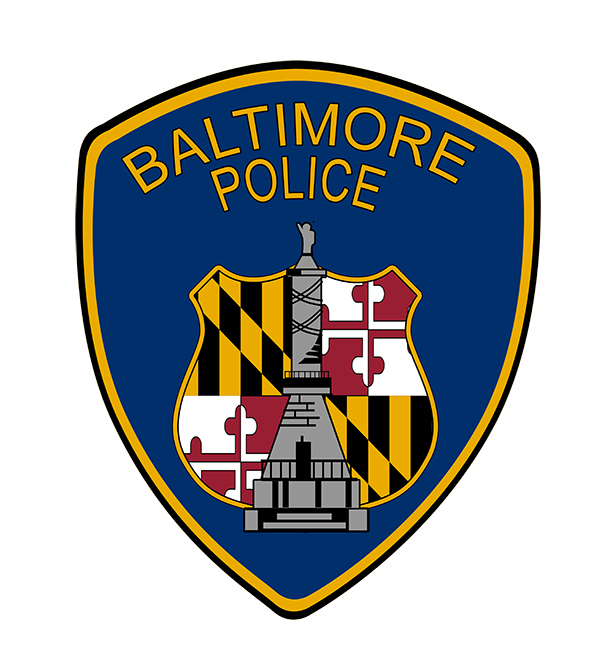
![]()
![]()




 Patrolman Thomas Norton
Patrolman Thomas Norton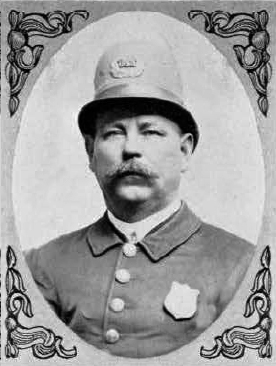 Patrolman Thomas Norton
Patrolman Thomas Norton